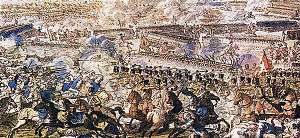Battle of Rymnik
| Battle of Râmnic | |||||||||
|---|---|---|---|---|---|---|---|---|---|
| Part of the Russo-Turkish War (1787-1792) | |||||||||
 Clash between Russo-Austrian and Turkish troops in the Battle of Rymnik | |||||||||
| |||||||||
| Belligerents | |||||||||
|
|
| ||||||||
| Commanders and leaders | |||||||||
|
|
| ||||||||
| Strength | |||||||||
| 100,000[3][2] | ||||||||
| Casualties and losses | |||||||||
| less than 1,000[4][5] | nearly 20,000[4][5] | ||||||||
The Battle of Râmnic (Turkish: Boze Savaşı) on September 22, 1789 took place in Wallachia, near Râmnicu Sărat (now in Romania), during the Russo-Turkish War of 1787-1792. The Russian general Alexander Suvorov, acting together with the Habsburg general Prince Josias of Coburg, attacked the main Ottoman army under Grand Vizier Cenaze Hasan Pasha. The result was a crushing Russo-Austrian victory.
Background
In September 1789, the Ottoman vizier Cenaze Hasan Pasha, vowing revenge for their forces' defeat at Focșani, raised an army of more than 100,000 soldiers, mostly Janissaries, to defeat the combined Austro-Russian armies under generals Alexander Suvorov of Russia and Prince Josias of Coburg. Sending his troops into a grueling night march, Pasha then attacked the 18,000-strong Austrian detachment. Taking into account Josias's numbers and their poor performance in the war, specifically after the Battle of Karánsebes, the Pasha was convinced that he could defeat this force easily. However, once he heard of this, Suvorov and his 7,000-strong force marched to their aid, covering about 100 kilometers in two and a half days, arriving on the eve of the battle. As the commander-in-chief of all Russo-Austrian forces in the front, he quickly took command of the combined Austro-Russian army.
Battle
Suvorov divided his combined army into two columns to advance towards the Ottoman formations at 2300 hours, and next morning, after crossing the river Râmnicul Sărat, attacked. As they advanced they crippled the enemy artillery and adopted infantry square formations to repel massive enemy cavalry counterattacks which tried to split his army in two. This done, the army stormed the enemy camp and routed them completely.
At 1500 hours, after storming the Ottoman fortifications near the village Bogsa and reuniting with the Austrian army, the combined army then advanced onto a general offensive towards the main Ottoman camp in the forest nearby. While the Austrians advanced and were pinning down enemy troops, the rest of Suvorov's army outflanked the enemy army and attacked them with cavalry, causing panic among the Ottomans who had almost nowhere to retreat but across the Râmnicul Sărat river, where most of them drowned while trying to cross it.
Casualties
At the cost of 700 casualties, Suvorov inflicted about 20,000 casualties against the Turks, who were now in full retreat from the Danubian Principalities. The Turks lost all their artillery and baggage train.
Aftermath
For this victory, Suvorov was awarded the title of "Count of Rymnik" (граф Рымникский, Graf Rymniksky) by the Russian Empress Catherine the Great. On the other hand, the Ottoman vizier Cenaze Hasan Pasha was dismissed on December 2, 1789, after his defeat.[6] Meanwhile, the Habsburgs occupied all of Wallachia until the war ended.
Gallery
-

The battlefield
-

Suvorov's monument (detail)
-

References
- ↑ Defeat of Turkish Army by Russo-Austrian troops in the battle of Rymnik Archived April 29, 2014, at the Wayback Machine.
- 1 2 Stone D. R. A Military History of Russia: From Ivan the Terrible to the War in Chechnya. Greenwood Publishing Group. 2006. P. 86
- ↑ Dowling T. C. Russia at War. From the Mongol Conquest to Afghanistan, Chechnya, and Beyond. ABC-CLIO, 2014. P. 751
- 1 2 Dowling T. C. Russia at War. From the Mongol Conquest to Afghanistan, Chechnya, and Beyond. ABC-CLIO, 2014. P. 752
- 1 2 Stone D. R. A Military History of Russia: From Ivan the Terrible to the War in Chechnya. Greenwood Publishing Group. 2006. P. 87
- ↑ Nicolae Iorga:Geschichte des ottomanischen Reiches Vol 5 (trans:Nilüfer Epçeli) ISBN 975-6480-22-X pg.83
Coordinates: 45°23′30″N 27°03′40″E / 45.3917°N 27.0611°E